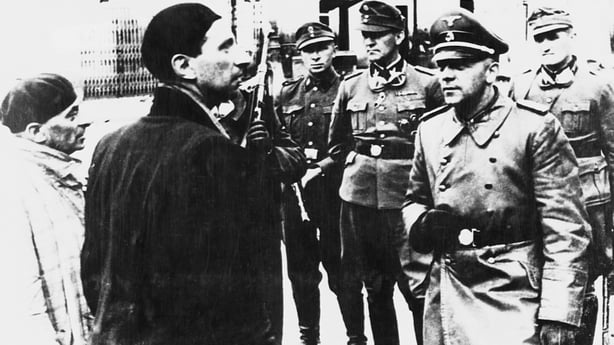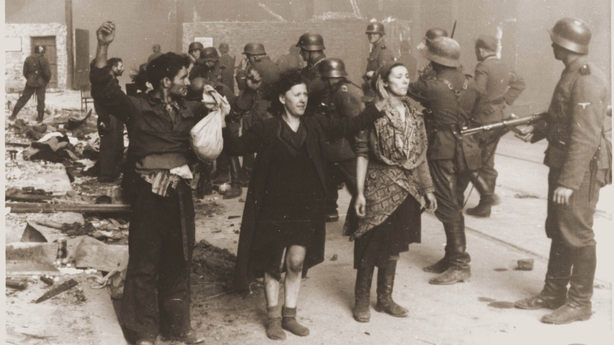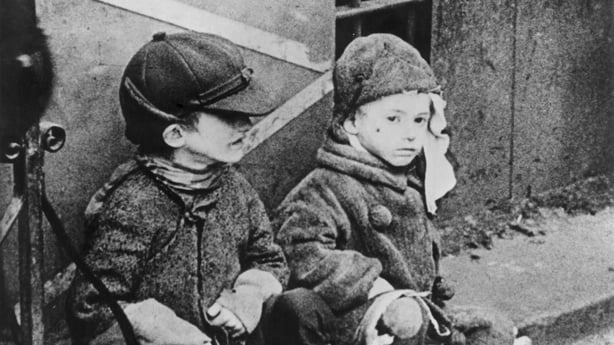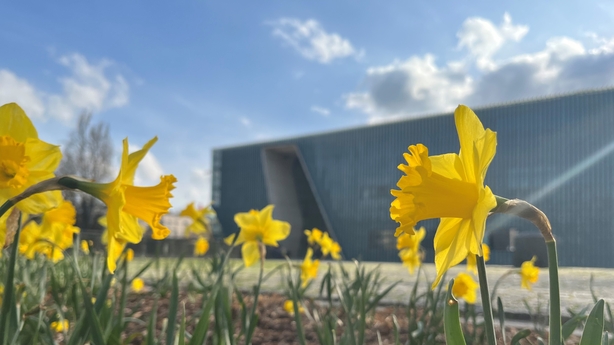At 91, Krystyna Budnicka (pictured above) is one of three known living survivors of the Warsaw Ghetto Uprising, which began 80 years ago today on 19 April 1943.
The month-long uprising was a brave attempt by Jewish fighters inside the ghetto to stave off German Nazi troops as they began their final liquidation of the ghetto's remaining 50,000 inhabitants.
"The first important thing was to survive, not to be caught and to hide when there were round-ups," Ms Budnicka told RTÉ News.
Ms Budnicka was in attendance at a ceremony today marking the 80th anniversary of the uprising, held at the Monument to the Ghetto Heroes in central Warsaw.
The presidents of Poland, Israel and Germany laid wreaths at the monument in memory of those who perished in the city's wartime ghetto.

Warsaw commemorates the uprising's civilian dead
Air raid sirens sounded in central Warsaw at 12 noon to signal the start of the solemn event, attended by relatives of survivors, foreign dignitaries and members of Poland's military.
Poland's President Andrzej Duda said the ghetto's fighters "gave their lives for freedom, but also for a free Poland."
Germany's President Frank-Walter Steinmeier said that it was important for Germans to know the history of the Warsaw ghetto, and asked for "forgiveness for German crimes".
Both Mr Steinmeier and Warsaw's Mayor Rafal Trzaskowski referenced Russia's invasion of Ukraine during their speeches.
Mr Steinmeier said that Russia's President Vladimir Putin had "violated the values of democracy" and that "we will stand by Ukraine".
Symbolically, the three presidents joined hands after laying wreaths at the monument.
But that did not stop the politics. Poland's ministry of culture released a statement saying that, during the day's events, Poland's Deputy Prime Minister and Minister for Culture Piotr Glinksi handed Mr Steinmeier a report on Polish losses during World War II.
In recent months, the Polish government has demanded reparation payments of €1.3 trillion from Germany for damage suffered during World War II. Germany's federal government says that the issue of reparations was settled in 1990.
Survivor's voice
Ms Budnicka was invited to pay her respects at the Monument of the Ghetto Heroes, ahead of the three presidents.
Her family had built a bunker three months before the uprising began to try and survive.
"My brothers went out to fight. Then the whole tragedy started because the Germans came with tanks, machine guns and they burnt house by house," said Ms Budnicka.
"It was terribly hot as everything was burning. We were escaping to the sewers for shelter. The Germans realised that the sewers were an escape route and they threw down gas bombs."
"We were between the sewers and the bunker. You went there [to the sewers] to cool down and then had to escape from gas the whole time."
Ms Budnicka was born Helena Kuczer in Warsaw in 1932, the youngest of eight children of Jewish parents, Józef-Lejzora and Cyrli Kuczer.
Her father Józef was a carpenter.
"We were not rich, just an ordinary family. My parents worked hard," said Ms Budnicka.
I interviewed Ms Budnicka ten years ago for an RTÉ History Show feature on the 70th anniversary of the Ghetto Uprising.
She is as alert and sharp-witted today as she was back then.
Two of Ms Budnicka’s brothers were killed in Treblinka. Her parents, four other brothers and her sister Pola all died during or in the months following the Ghetto Uprising.
"I was underground for about eight months. When I emerged, I was alone," recalled Ms Budnicka.
Before World War II, about one-third of Warsaw's one million inhabitants were Jewish.
In November 1940, more than one year after Nazi Germany’s invasion of Poland, German authorities ordered all Jews in Warsaw to move into the city's walled ghetto.

Its population swelled to an estimated 450,000 people, living within an area of just 3.5 square kilometres. Rampant disease and hunger killed many.
Starting in July 1942, the Nazis began to deport 300,000 of Warsaw's Jews to a death camp in Treblinka and other camps.
The uprising was a final act of heroism by fewer than 1,000 poorly armed men and women in the face of near certain death.

Past commemorations of the uprising have focused on the bravery of the Jewish fighters.
For this year's 80th anniversary however, organisers at POLIN (the Museum of the History of Polish Jews which stands in the same square as the monument) decided to focus on the ghetto's civilian population – those who had resisted German deportation orders and remained in hiding.
An estimated 13,000 Jews died during the uprising. Most of the remaining residents were deported to concentration camps.

Joanna Fikus, head of the exhibition department at POLIN, told RTÉ News that the museum wanted to "bring back the names" of the civilians who had remained in the ghetto.
This year’s exhibition 'Around us a Sea of Fire’ tells the story of 12 civilians who documented their time in the ghetto in diary form. Ms Budnicka is one of those whose story of survival is told.
The exhibition designers have recreated the experience of being inside a bunker. Rooms are divided by large concrete slabs and original sketches and designs of bunkers hang on walls.
Also on display is a series of newly discovered photographs, taken clandestinely by a Polish firefighter named Zbigniew Grzywaczewski inside the ghetto following the uprising.

Paper daffodils, a symbol of remembrance for those who died during the 1943 uprising, will also be handed out by volunteers in Warsaw and in four other Polish cities.
Ms Budnicka went on to survive the Warsaw Uprising of 1944 - the Polish Home Army's nine-week uprising against German forces throughout the city.
She took her surname after the Budnicki family who had looked after her following the war.
She remained in Warsaw all of her life and studied degrees in pedagogy, becoming an activist for the Children of the Holocaust Association.
"We always need to remember and commemorate that this cruelty could happen in a civilised world. We always need to shout: 'War, never again'," said Ms Budnicka.






